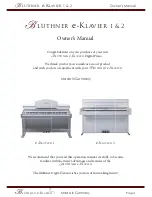
CALIBRATION
5-14
3. Standard Resistor Calibration
This procedure determines the value of the internal standards for the different frequencies and ranges.
The SR715/720 does this by measuring a precisely known resistor and recomputing the values it uses
when calculating the impedance of a part. These values are the primary accuracy standard of the
instrument, so the exact value of the calibration resistor, both real and imaginary parts, must be known. In
addition, the SR715/720 and the calibration resistors must be placed in a temperature controlled room and
allowed to stabilize at least 30 minutes before attempting to calibrate.
The standard cal menu is entered as follows. Press the [Calibrate] key until "Std cAL" appears on the
display. Press [ENTER] once to get into this menu structure. Next press [Calibrate] until the "rAngE"
message appears on the left display. From here the desired range can be entered (using the [0]-[3] keys
and [ENTER]) and will appear on the right display. After the range has been entered, pressing [Calibrate]
will cycle through a series of menus. Pressing [ENTER] in any of these will either load that value or begin
the action listed. Two different parameters must be set, "r Std" (standard resistor resistance value) and
"q Std" (Q of the standard resistor). Resistance values are entered using the [
Ω
], [k
Ω
] and [M
Ω
] keys and
Q is entered in ppm's. Negative Q's denote capacitive resistors and positive Q's denote inductive ones.
The different actions are "StArt cAL" (start cal), "Fctry cAL" (factory cal) and "quit cAL" (quit cal). These
activities will, in order, begin calibration of the current range, recall the factory default values, or exit the
cal menu.
1) Inspect the fixture contacts for dirt or waxy build up. If the fixture appears dirty, clean it as described in
the maintenance section. Remove any adapters or components from the fixture.
2) Using the precision open and short circuit from the calibration kit, perform open and short circuit. See
the operation section for details on this.
3) Plug the R0 Calibration Resistor into the fixture. Enter the cal menu as described above and enter
range 0. Press [Calibrate] until "r Std" (resistance standard) is displayed. Enter the resistance of R0.
Press [Calibrate] to display "q Std" (Q standard) and enter the Q of the standard in ppm. Press
[Calibrate] to display "StArt cAL" (start cal). Begin the calibration by pressing [ENTER] making sure to
keep hands and any other objects away from the fixture.
4) Repeat step 3 for the other three ranges (1, 2 and 3). When finished, exit the cal menu by pressing
[Calibrate] until "quit cAL" is displayed and then pressing [ENTER].
5) After calibration, verify that the calibration is accurate. Peform open and short circuit calibration. Insert
the standards in the fixture and measure them at 1 kHz, series equivalent circuit. The R and Q
readings should agree to within one least significant digit of the standard values.
6) Check the standards at different frequencies. Use series for the two smaller resistors and parallel for
the two larger ones. R should remain relatively constant and Q should scale with frequency (i.e. Q at
10 kHz is 10x Q at 1 kHz). If any of the values are too far from the nominal values, recalibrate that
range.
7) Before making measurements, run open and short circuit calibration with the fixture configuration to
be used.
Содержание SR715
Страница 5: ...SR715 720 LCR METER iv ...
Страница 46: ...ACCURACY 3 3 ...
Страница 94: ...MAINTENANCE 6 8 ...
















































